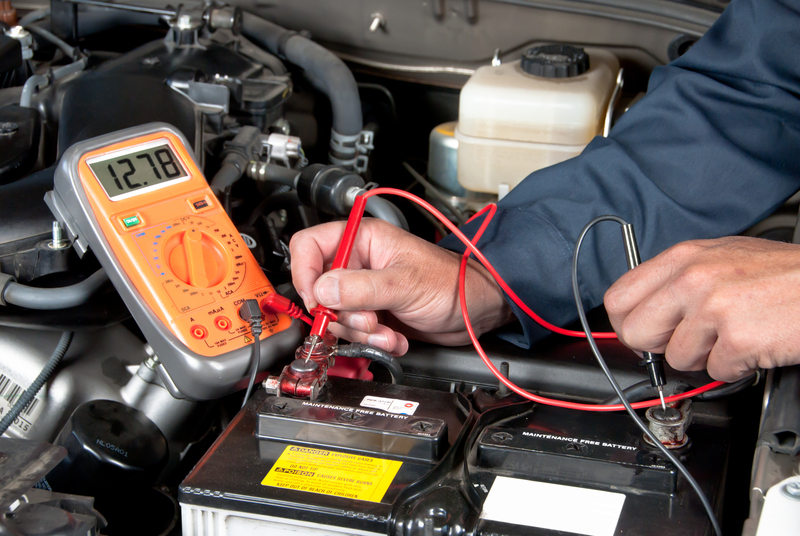Proper Storage Secrets for a Freezer Not in Use
Posted on 26/06/2025
Proper Storage Secrets for a Freezer Not in Use
Have you ever found yourself with an extra freezer that you're not planning to use for a while? Knowing the right way to store a freezer not in use is key to prolonging its lifespan, keeping it clean, and preventing costly surprises down the road. In this comprehensive guide, we'll unveil the essential secrets for proper storage of an idle freezer, whether you're storing it off-season, between moves, or simply keeping it in reserve. Discover expert tips, actionable steps, and answers to common questions about freezer storage safety and maintenance!

Why Proper Storage of an Unused Freezer Matters
Storing a freezer when it's not in use might seem straightforward, but it's more complicated than unplugging and forgetting about it. Improper storage can lead to mold, mildew, unpleasant odors, pest infestations, and mechanical issues when you need to use your freezer again.
- Moisture Buildup: Leaving moisture inside the appliance creates a perfect breeding environment for bacteria and fungi.
- Foul Odors: Food residue or moisture can cause bad smells to develop, which can be tough to eliminate later.
- Rust and Corrosion: Residual liquids and condensation can rust metal parts and damage interior linings.
- Pest Attraction: Even tiny food scraps can attract rodents or insects if the freezer is stored in a garage, shed, or basement.
- Mechanical Trouble: Inadequate preparation can harm compressor components, seals, and electrical elements.
Getting Ready: Preparing Your Freezer for Storage
Preparation is the cornerstone of proper storage for a freezer not in use. Follow these step-by-step instructions to ensure your appliance is ready for its break:
-
Empty the Freezer Completely
- Remove all food and ice trays.
- Check for anything forgotten at the back or in shelves.
-
Defrost Thoroughly
- Unplug the freezer and leave the door open to let frost and ice melt naturally.
- Use towels to soak up excess water as the ice melts.
-
Clean and Sanitize
- Wipe down all surfaces with a mixture of baking soda and warm water or a mild disinfectant.
- Pay special attention to corners, gaskets, and crevices where mold might lurk.
- Let all parts air dry completely before closing any doors or covers.
-
Remove or Secure Shelves and Drawers
- Take out removable shelves and drawers to clean individually and prevent any warping or mildew.
- If you prefer to keep them inside, make sure they are bone dry.
Location Matters: Choosing Where to Store Your Freezer
The ideal location plays a crucial role in keeping your freezer in optimal condition during its downtime. Let's look at the best practices:
- Dry, Cool Spaces: Avoid places prone to moisture or extreme temperatures, such as damp basements or hot attics.
- Well-ventilated Areas: Stashing your freezer in a spot where air can circulate helps prevent condensation and rust.
- Flat, Stable Surface: Store the freezer upright on a level, firm floor to avoid putting pressure on internal components.
- Away from Sunlight: Direct sunlight can discolor exterior panels and increase the risk of overheating and seal damage.
Garages, spare rooms, covered patios, or climate-controlled storage units are often the safest choices for long-term freezer storage.
Should You Store a Freezer Upright or On Its Side?
Always store your freezer upright! Laying it on its side or back can cause compressor oil to flow out of proper channels, risking serious damage. If the unit must be moved on its side for transport, always let it stand upright for at least 12-24 hours before plugging it in again to let the oil settle.
The Right Way to Leave a Freezer Unused: Door Etiquette
One of the biggest secrets in storing a dormant freezer is managing the door correctly. Here's what you need to know:
- Always leave the freezer door ajar! This is essential to prevent musty odors, mold growth, and stagnant air.
- Use a wedge, block, or even a rolled towel to keep the door open about 1-2 inches.
- Never use tape to seal the door shut for extended periods--it traps moisture and breeds bacteria and mold.
Some models come with built-in spacers for this exact purpose, so check your freezer's manual for tips.
Keeping Pests and Moisture Out During Long-Term Storage
Pest prevention and humidity control are two silent threats you don't want to overlook when storing a freezer not in use. Here's how to tackle them:
Pest-Proofing Tips
- Vacuum all crevices and gasket grooves for food crumbs.
- Set up rodent repellents or mothballs nearby (not inside!) if storing in a garage or shed.
- Use thick plastic sheets or appliance covers to keep dust and insects away from vents and coils.
Controlling Moisture and Odor
- Place an open box of baking soda or a few activated charcoal briquettes inside to absorb humidity and neutralize odors.
- Check the area periodically for leaks or drips that could encourage rust or mildew.
- If possible, use a small dehumidifier in damp spaces.
Remember: Avoid storing anything inside the freezer itself except moisture-absorbing agents.
Periodic Checkups: Maintenance for a Non-Operating Freezer
Although your freezer isn't running, it's wise to perform occasional inspections. Doing so helps you catch problems--such as new odors, rust, or vermin signs--before they worsen.
- Open the door every month or so to refresh the interior air.
- Replace baking soda or charcoal as needed for ongoing odor control.
- Look for external or internal signs of condensation, corrosion, or pest activity.
- Confirm the freezer remains stable and upright on its base.
Reactivating a Freezer After Storage: Best Practices
When you're ready to put your freezer back into service, follow these key steps to avoid damage and ensure safety:
- Re-clean the interior with a mild disinfectant or baking soda solution.
- Let the freezer sit upright (if moved) for 12-24 hours to allow compressor oils to resettle.
- Check the power cord for damage and plug the unit into a grounded outlet.
- Run the empty freezer for several hours to verify it reaches and holds your desired temperature.
- Add food once fully cold and frost-free.
Common Mistakes to Avoid When Storing an Unused Freezer
Here are some errors to steer clear of for proper storage of a freezer not in use:
- Leaving food or trays inside, which can spoil and rot.
- Sealing doors completely, causing mold and mildew.
- Storing in excessively humid or wet locations.
- Neglecting to clean and dry before unplugging and storing.
- Laying the freezer on its side or back without following manufacturer instructions.
- Forgetting to check on the appliance until needed again--routine checks prevent surprises!

Answers to Frequently Asked Questions About Storing a Freezer Not in Use
Q: How long can I store a freezer unplugged?
A: If properly cleaned, dried, and kept in a dry place, there's technically no time limit. Many freezers can be unplugged for months or even years if precautions above are followed.
Q: Is it safe to cover my freezer during storage?
A: Yes, but use breathable materials like cotton blankets or specially designed appliance covers. Avoid fully airtight plastics that trap moisture.
Q: What if I smell something strange coming from the freezer?
A: Act quickly! Odors are often the first sign of mold, mildew, or leftover food residue. Thoroughly clean, air out, and add odor absorbers as directed above.
Q: Should the freezer be locked when not in use?
A: Generally, keep it unlocked to allow ventilation. If safety or security is a concern (such as in a home with children), use a lock but regularly open for air exchange.
Q: Can I store items inside a disused freezer?
A: Besides odor absorbers, it's not recommended to store other items. Books, clothing, tools, and other goods can absorb odors or moisture and suffer damage.
Summary: Secrets to Successful Unused Freezer Storage
Storing a freezer not in use doesn't need to be a hassle, but small mistakes can have big consequences. Prepare the appliance by cleaning and drying it completely, storing it upright with the door ajar, and monitoring for pests and moisture. Choose your storage location wisely and avoid classic pitfalls like sealing the door or neglecting regular inspections.
- Clean, dry, and air out thoroughly before storage.
- Keep the appliance door propped open with a wedge or block.
- Choose cool, dry, and stable locations.
- Perform regular maintenance checks.
- Use moisture and odor absorbers as needed.
Follow these proper storage secrets for a freezer not in use, and you'll extend its working life and minimize unpleasant surprises when it's time to freeze again!



